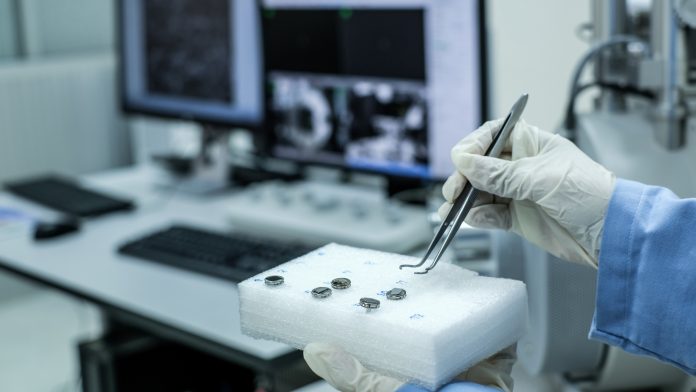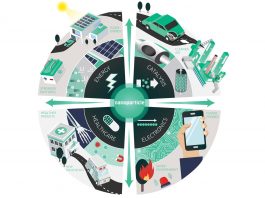Northeastern University’s Professor Thomas J Webster explains how nanomaterials and biomaterials can be used to prevent, diagnose, and treat diseases.
At the Chemical Engineering Department at Northeastern University, research and technology brings innovation to chemical engineering. From growing new cartilage cells to help osteoarthritis, to improving drug delivery for cancer patients, chemical engineering offers new solutions to some of the greatest societal challenges using nanomaterials and biomaterials.
Within the department, Professor Thomas J Webster and his team focus on the design, synthesis, and evaluation of nanomaterials for various medical applications, including self-assembled chemistries, nanoparticles, nanotubes, and nanostructured surfaces.
The Innovation Platform spoke to Webster about his research into using nanomaterials to prevent, diagnose, and treat diseases such as cancer, as well as how he is working to develop in situ sensors which can sense biological responses to medical devices and respond in real time to ensure implant success.
Could you begin by outlining your main research interests/areas of focus for your department?
My research and education interests are in nanomedicine, or the use of small materials to help prevent, diagnose, and treat diseases. We have been interested in a large number of diseases, including cancer; diabetes; infection (both viral and bacterial); tissue regeneration for bone, vascular, heart, bladder, skin, nervous system, brain, cartilage, etc.; mitochondrial diseases; arthritis; osteoporosis; and more.
We have a long history of success in spinning out companies from our research and obtaining regulatory approval (such as from the FDA) for our nano devices. We are engineers who develop unique nanoparticle chemistries (we can make nanoparticles out of almost anything on the periodic chart) and geometries (not just typical nanospheres, but also nanofibres, nanostars, and others that have unique properties to fight diseases).
Currently, we are focussed on implantable sensors that can both detect if a person has a disease and then respond to get rid of it. We are also focussed on making environmentally friendly nanoparticles since many nanoparticles synthesised through conventional chemistry today involve toxic materials. We are using cells to make nanoparticles which are less toxic, and the particles perform even better to fight diseases.
How are you looking to develop nanomaterials for tissues such as bone, cartilage, skin, nervous system, bladder, cardiovascular, and vascular? What particular challenges are involved? What successes have you seen?
For our tissue engineering work, we have two main thrusts: in one, we take off-the-shelf medical devices (like knee or hip implants) and figure out a way to implement nanostructured surface features (or nanotextures). These nanotextures mimic the natural nanometre roughness of those tissues to enhance tissue growth, reduce infection, and inhibit scar tissue growth. Some 25 years ago when we first started, few (if any) people recognised that cells make the nanomaterials that constitute our tissues, and thus that nanomaterials would be great materials for regrowing tissues.
As we do not necessarily focus on drugs, we try to create surfaces that can control cell functions without drugs (since they have many side effects in the body and can lead to chemotherapeutic resistant cancer cells, antibiotic resistant bacteria, etc.). This is where we have had the most success in terms of starting companies and getting regulatory approval for our implants, some of which are in humans today.
The second area of our tissue engineering work is to use self-assembled nanomaterials that are liquid at room temperature and then solidify after injection into the body. This approach is much better than implanting a piece of metal, as the surgical site incision is minimised (and thus causes less disruption to the body), and these materials degrade as the tissue grows. Self-assembled nanomaterials are materials that are made synthetically and can assemble into controllable nanostructures (spheres, fibres, etc.) once injected into the body.
How can nano biomaterials play a role in anti-cancer applications, and how are you contributing to this?
We are contributing in two ways to anti-cancer applications. First, like many groups, we are developing multi-functional nanoparticles that can detect and kill cancer cells simultaneously. This area is called ‘theranostics’ – where you combine therapy with diagnostics. However, our approach is somewhat different, in that we focus on biodegradable nanoparticles that are part of our diet, like iron and selenium. In this way, since cancer patients suffer from weakened immune systems, we are using chemistries that can boost your immune system after they have detected and killed cancer cells.
Secondly, sticking to the tissue engineering research mentioned above, we are creating materials that can regrow healthy tissue in the place of where a tumour once was. For example, we are creating nanotextured polymers that can regrow healthy breast, lung, and bone tissue after a tumour is removed and which can keep the cancer from returning. We have learned that nanotextures themselves can reduce cancer cell functions and the return of cancer after a tumour is removed is a significant problem in medicine today.
You are also developing in situ sensors which can sense biological responses to medical devices and respond in real time to ensure implant success. How is this being approached?
This is one of the things I am most excited about at the moment. I firmly believe that over the next 10 years, our traditional way of thinking about healthcare will change. I also believe that our old fashioned, bricks and mortar hospital system will change. A lot of this has been brought on by COVID-19 – overcrowded hospitals; people afraid to go the hospital for fear of catching COVID-19; medical treatments that are the same and not personalised to how individuals will respond to an implant or drug; our healthcare being reactionary rather than predictive; and so much more.
For me, the answer to this is implantable sensors. On a basic level, we are growing sensors off medical devices to determine what type of cells attach (bacteria, immune cells, or tissue forming cells). A message is then sent to the patient’s mobile phone, and a doctor can then release something (we hope a nanoparticle!) from the implant’s surface to control biological events and so ensure implant success. On a more advanced level, we are developing nanoparticles that can do the same thing independent of a medical device. In this way, we can detect diseases and respond to them in a much earlier and personalised way than what is done today.
Where will your interests and priorities lie moving forwards?
We will definitely continue to focus on these implantable sensors. However, I am also very interested in green nanomedicine, where cells are used to make nanoparticles. As previously mentioned, so many of the chemical methods used today rely on somewhat toxic chemicals, which in part has drawn a lot of criticism around nanomaterial toxicity. When programmed correctly, cells can make nanoparticles (whether bacteria or cancer cells) and we are finding that when they do, those nanoparticles can selectively kill antibiotic resistant bacteria and cancer cells (dependent on what cell made them) which improves medicine!
 Professor Thomas J Webster
Professor Thomas J Webster
Chair and Professor
Department of Chemical Engineering
Northeastern University
+1 617 373 2989
th.webster@northeastern.edu
https://che.northeastern.edu/
Please note, this article will also appear in the fourth edition of our new quarterly publication.









